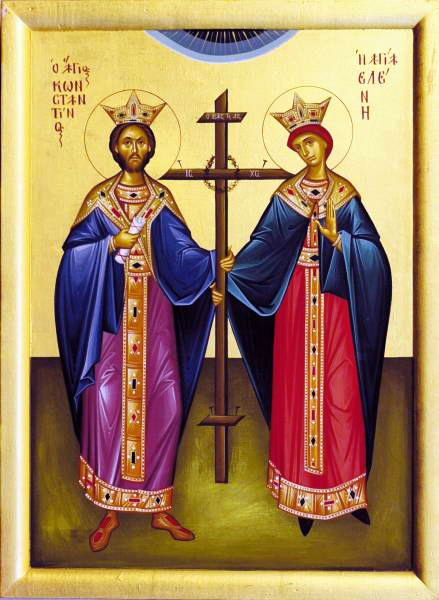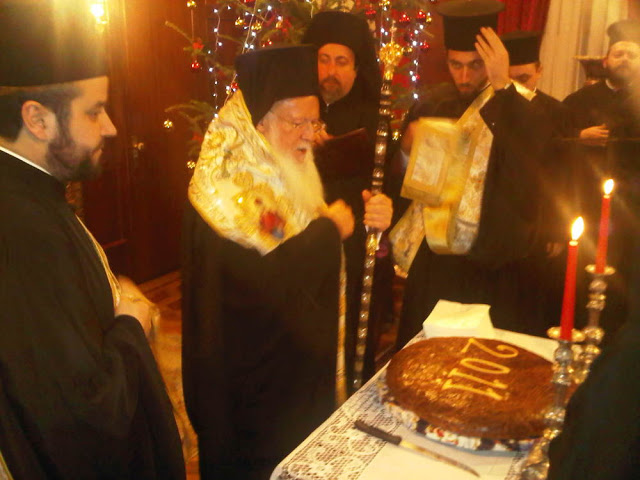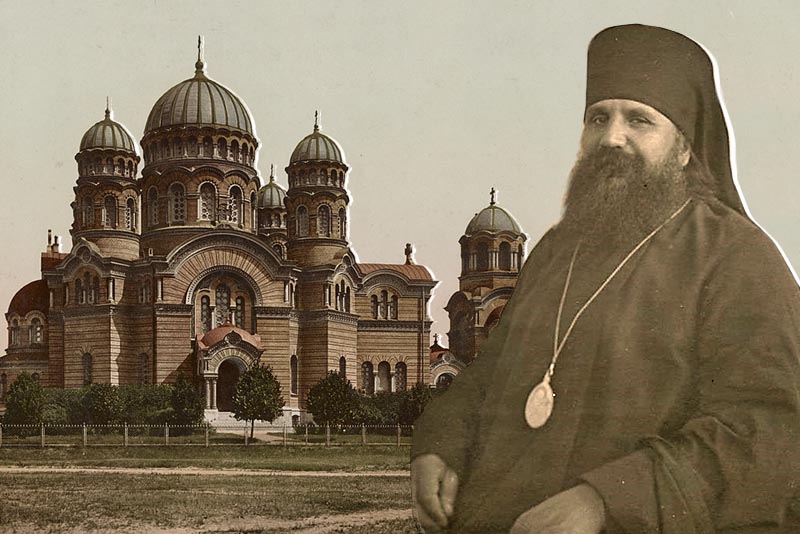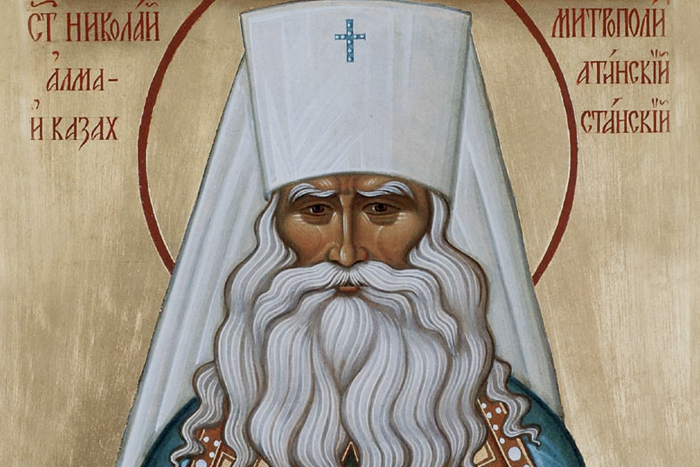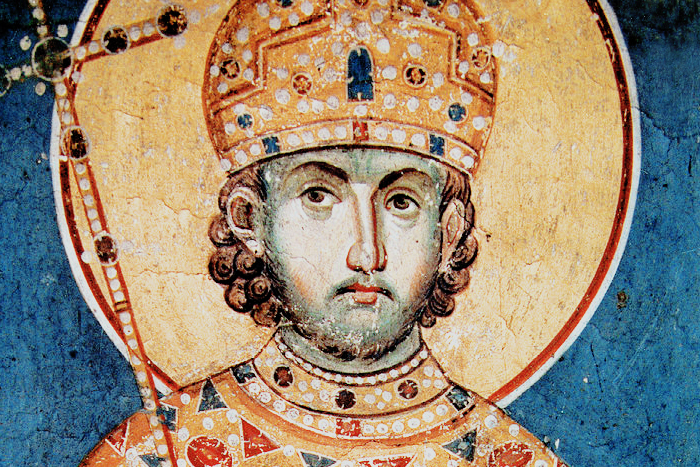
Let’s take another break from our travels and hear the story of events and people of the fourth century, mostly in Greek-speaking lands, which determined the future of Christianity and the world. All these are commemorations on the Orthodox calendar at this time of year, and all relate directly to the First Ecumenical Council.
Today, we’ll hear about the Emperor Constantine, commemorated on May 21 along with his mother Helen. Then in succeeding weeks, we’ll tell the story of the Fathers of the First Ecumenical Council called together by the Emperor Constantine, commemorated on the Sunday after the Ascension (May 28 this year). Finally we’ll hear the account of the leading light of that Council, the wonderful Saint Athanasios the Great, whom the Church honors on May 2.
I am no historian and no scholar, so if there are errors or questionable assertions in what follows, I ask those who know more than I do please to correct me. Today’s world already has enough “alternate facts” being passed around. In what follows I have made considerable use of The Holy Fire: the Story of the Fathers of the Eastern Church by Robert Payne. I found this book exciting easy reading, though if you read it don’t skip the preface by Father Thomas Hopko who points out a few errors.
Saint Constantine the Great, Equal to the Apostles

Was Constantine an ascetic? No. Was he a brilliant theologian? No. Was his moral life exemplary? Not always, by any means. Was he a miracle worker? No. Was he even a Christian? Not formally, until he was finally baptized almost on his deathbed. So why does the Church call him a saint? Read on.
By the late third century AD the great Roman Empire had four emperors. (This questionable move was made for administrative purposes.) Constantine was son of the Emperor Constantius who ruled the far west: Britain, Gaul and Spain. Constantine’s mother was Helen (Helena, Eleni) an innkeeper’s daughter, whom Constantius had married, then divorced for political reasons – though some say they were never married. He then married a daughter of his senior western emperor Maximian, who was based in Trier in Gaul, a persecutor of Christians. Constantine and his mother remained close. She raised him as a boy in her home town of Drepanum in northwest Asia Minor, in the region where later he would build his new imperial city. Helen, who was either a Christian or sympathetic to Christianity, had a profound influence on her son.
As a young man Constantine was trained in the court of Diocletian, one of the co-emperors of the east *, who was brutally attempting to eliminate Christianity, and then he went to join his father in Britain. When Constantius died the troops acclaimed Constantine king; this was in the year 306 in York in England. *Yes, I know, all these emperors get confusing, and we’re just getting started. I hope I’ve kept them straight.
Constantine was ambitious. His goal was to reunite the Roman empire under himself. Maxentius was then emperor in Italy. Constantine and his army marched south, prepared to meet his far superior forces. While crossing the Alps Constantine had a strange and transformative experience. This was the story he told ever after: In the morning sky he saw (some accounts say others saw it with him) a shining cross with the words “In this sign conquer”. Some say it was in Greek “En touto nika”, others that it was Latin “In hoc signum vincit”. This rather fanciful portrayal is by Rafael.
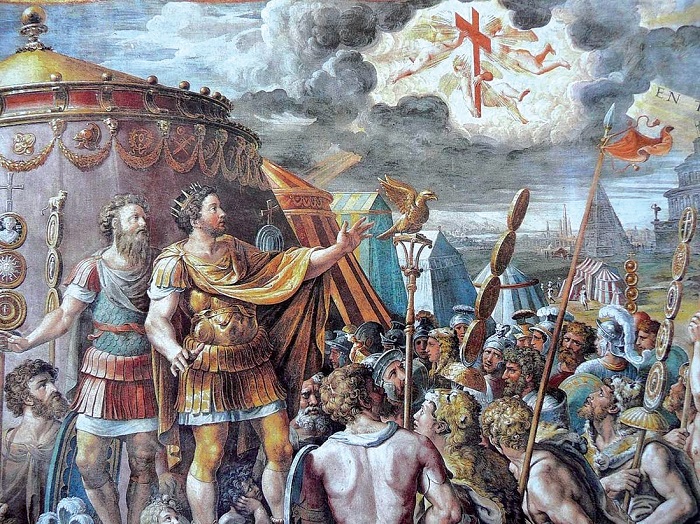
At the time Constantine was still a pagan who seems to have worshipped the sun as the high god. But he must also have had Christian sympathies, perhaps because of his mother, for he had Christian priests accompanying his army, and they explained the vision to him. So he had the Chi-Rho painted on his army’s banners. One of the banners was kept in Constantinople fo r many centuries. (Probably it was destroyed by the Crusaders, along with many other things including the future of the Byzantine Empire.) The armies met at the Milvian Bridge on the River Tiber outside Rome, and Maxentius was defeated. It was October in the year 312.
r many centuries. (Probably it was destroyed by the Crusaders, along with many other things including the future of the Byzantine Empire.) The armies met at the Milvian Bridge on the River Tiber outside Rome, and Maxentius was defeated. It was October in the year 312.
Constantine was now Augustus, sole emperor of the west, but he was not like other emperors. When he marched into Rome, he did not make the customary reprisals against the vanquished. More significantly, he boldly refused to make the customary sacrifices to the Roman gods. This was dangerously “politically incorrect”, for the Roman elite were chiefly pagan. Even though Christians were highly suspect, one of his first acts was to forbid the persecution of Christians. His famous Edict of Milan, made in the year 313 jointly with Licinius, the new emperor of the east, declared tolerance for all religions. And from the beginning Constantine gave special privileges to the Church. He ruled that the Church could again own property and directed the return of seized property. He ordered the return of Christian exiles. He decreed that the Christian Lord’s Day (“Kyriake” in Greek), the day of Christ’s resurrection, be the imperial weekly holiday. (“Sunday” is a pagan name for the first day of the week.)
Do you want to know about Constantine’s family life? It was not exactly “saintly”. He set aside his first wife Minervina to marry Fausta, daughter of yet another emperor Maximianus. He thought highly of her, had her proclaimed Augusta, Empress. But some years later without explanation he had his oldest son Crispus executed and Fausta smothered in her bath. (Gossip said it involved adultery or worse. We will never know.) Constantine never married again. Quickly he had his mother Helen shown here declared Augusta. In the eyes of Christians she came to play a role similar to that of Christ’s Mother
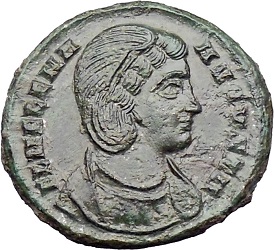
Emperor Licinius in the east had signed the edict of Milan but had now taken to persecuting Christians again. Constantine soon decided to reunite the empire under himself and under the Christian God. He and his army moved east. In May 324 the combined armies numbering over 300,000 men met outside the Greek city of Adrianopolis. (In those days wars were usually fought outside cities and did not normally involve civilians. May we please go back to the old days?) Licinius was defeated and fled and finally surrendered that September. Constantine was now sole emperor, east and west.
Now the empire was united under the Christian God. However, to Constantine’s great frustration, Christians were not united. Far from it, there was bitter division between the Orthodox and the Arians, who denied the divinity of Christ – or it may be they just misunderstood the meaning of divinity. So one of Constantine’s first acts, the next spring, was to call a Council of Christian bishops in Nicaea, a city on the west coast of Asia Minor, to try to unite the Church. It is said 318 bishops attended. This became known as the First Ecumenical Council. Constantine himself presided and gave great honor to those who had been injured during the persecutions. It is not clear whether Constantine understood the theological issue. Above all he wanted unity. Among the bishops at the Council, at least, he got it. After some early contention, the final vote was 316 (probably) to 2 against Arius and for the Orthodox. (We’ll hear more about this next week.)This is the hall where it took place.
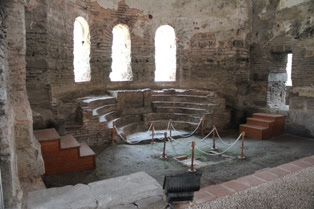
Constantine’s next great act was to move the imperial capitol from Rome to a new city he built at the little town of Byzantium, a strategic position on the Bosporus, which came to be called Constantinople, Constantine’s city. (Today the Turks call it by almost the same name, Istanbul, which is colloquial for “to Constantinople”. Say “isin Constantinople” fast a few times.) The new capitol was dedicated on May 11, 330, and put under the protection of the Theotokos. Why the move? To escape the pagan traditions of Rome? Because the east was the cultural and economic center of the empire? For sentimental reasons – because he had been raised near there by his mother? Perhaps all of the above. In any event it was a providential move, for only a century later the old Rome would fall to barbarians from the north. And so began the history of what has come to be called the Byzantine Empire, the longest-lasting, most influential empire in human history.
Constantine’s mother the empress Helen now enters the story again. She made a pilgrimage to Palestine, the Holy Land. (I told you in Blog Post 3, March 13, how she commissioned at least one church along the way, Ekatontapiliani on Paros.) Jerusalem had been destroyed by the Romans in the year 70, and the site was now a pagan town, Aelia Capitolina. Helen sought out the holy sites connected with our Lord Jesus Christ. She commissioned churches to be built at Bethlehem in honor of Christ’s Nativity, and in Jerusalem the church of the Resurrection, the Anastasis, at the site of Christ’s tomb.
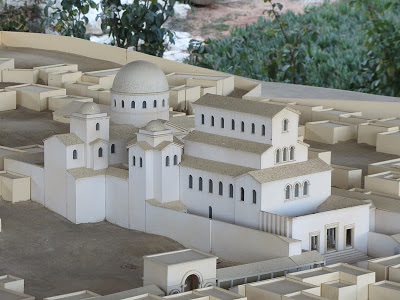
After her death her son Constantine went to Jerusalem for the dedication of the Anastasis, the Church of the Resurrection, on September 13, 336. The joy and exultation of Christians was almost beyond belief. Less than 25 years before, the empire was trying to exterminate the Church. Now the emperor, The Emperor!, had come to honor Jesus Christ! It felt like the whole world was being renewed. We still commemorate this every September 13. Listen to to one of the hymns from the day: “Take off the old man and be clothed in the new. Celebrate the renewal of your soul… Let your whole life be renewed, for the old things have passed away, and behold, all is made new. Let the fruit of this feast be for you a change for the good, for mankind is renewed, and the feast of the Renewal is now being celebrated.” (First Doxasticon from the Praises of Festival Orthros) It seemed like “the Kingdoms of this world [had] become the Kingdom of our God and of his Christ.” For a while.
All this time Constantine had never been baptized. Historians wonder why. Some people at the time (mistakenly) delayed Baptism till late in life, lest they fall into major sin after the Washing. Even the great Saint Basil, raised in a profoundly Christian family, was not baptized till he was an adult. Or maybe Constantine delayed for political reasons, not wanting to entirely abandon the pagans, so he could be emperor “to all the people”. He never explained. But early in the year 337 he fell ill and quickly was baptized. It is said he abandoned his imperial garments and wore only his white baptismal robe for the rest of his life, which was not long. He died on Pentecost, May 21, 337, and ever since on this day the Church has honored him and his mother.
As I said at the beginning, Constantine was not a saint in the usual sense. He was a politician, with all the compromises that entails. But no saints begin as saints; they are ordinary people who become extraordinary. There is every evidence that Constantine became a devout Christian before he was done. But we honor him chiefly for what he did for the Church and the world. Constantine ended the Great Persecution of the Church, and through him the Roman empire became Christian. It was because of Constantine that Christendom as we knew it till recently existed, and that hundreds of millions of people through the centuries up to our own day have had the opportunity to be Christians, to know Christ, to be part of the Church, to attain eternal life. In that sense Constantine was a miracle-worker. And the one who set him on that course and helped him establish it was his mother Helen. It is right that the Church titles them both as “Equals to the Apostles”.
